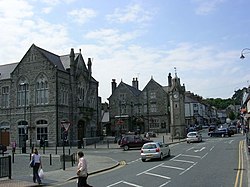Llangefni: Difference between revisions
mNo edit summary |
No edit summary |
||
| Line 13: | Line 13: | ||
|constituency=Ynys Môn | |constituency=Ynys Môn | ||
}} | }} | ||
'''Llangefni''' is a town in the centre of [[Anglesey]]. | '''Llangefni''' is a town in the centre of [[Anglesey]]. Llangefni is the principal commercial and farming town on the island; a practical town rather than a pretty one, at the heart of the island but no draw for tourists. It is the second largest town in the county (and the largest on the island of Anglesey itself) - the county's largest town, [[Holyhead]], is a port town principally concerned with port operations and culturally distanced from the cultural, commerce and language of the rest of the county. | ||
According to the Census of 2001, the population of Llangefni was 4,662 people. The census also reveals that 83.8% of the population speak Welsh fluently, with the highest percentage of speakers being in the 10-14 age group where 95.2% are able to speak Welsh. | |||
The town lies at the centre of the island on the [[River Cefni]], after which it is named, and is home to the Oriel Ynys Môn museum, detailing Anglesey's history and housing the legacy collection of Charles Tunnicliffe. In the west of the town is a large secondary school, [[Ysgol Gyfun Llangefni]] (Llangefni Comprehensive School), and in the north a Victorian church, St Cyngar's, set in a wooded riverside location known as The Dingle. The church provided the former name of the town, Llangyngar. | The town lies at the centre of the island on the [[River Cefni]], after which it is named, and is home to the Oriel Ynys Môn ("Isle of Anglesey Gallery") museum, detailing Anglesey's history and housing the legacy collection of Charles Tunnicliffe. In the west of the town is a large secondary school, [[Ysgol Gyfun Llangefni]] (Llangefni Comprehensive School), and in the north a Victorian church, St Cyngar's, set in a wooded riverside location known as The Dingle. The church provided the former name of the town, Llangyngar. | ||
Outside Llangefni is industrial estate, large by the island's standards, housing a slaughterhouse and several other small businesses. | Outside Llangefni is industrial estate, large by the island's standards, housing a slaughterhouse and several other small businesses. | ||
| Line 27: | Line 27: | ||
Anglesey Council has its main offices in Llangefni. | Anglesey Council has its main offices in Llangefni. | ||
== | ==Outside links== | ||
* | *{{geograph|3589585|Llangefni}} | ||
==References== | ==References== | ||
{{reflist}} | {{reflist}} | ||
Latest revision as of 10:38, 27 August 2013
| Llangefni | |
| Anglesey | |
|---|---|

| |
| Location | |
| Grid reference: | SH4675 |
| Location: | 53°15’0"N, 4°18’36"W |
| Data | |
| Population: | 4,662 |
| Post town: | Llangefni |
| Postcode: | LL77 |
| Dialling code: | 01248 |
| Local Government | |
| Council: | Anglesey |
| Parliamentary constituency: |
Ynys Môn |
Llangefni is a town in the centre of Anglesey. Llangefni is the principal commercial and farming town on the island; a practical town rather than a pretty one, at the heart of the island but no draw for tourists. It is the second largest town in the county (and the largest on the island of Anglesey itself) - the county's largest town, Holyhead, is a port town principally concerned with port operations and culturally distanced from the cultural, commerce and language of the rest of the county.
According to the Census of 2001, the population of Llangefni was 4,662 people. The census also reveals that 83.8% of the population speak Welsh fluently, with the highest percentage of speakers being in the 10-14 age group where 95.2% are able to speak Welsh.
The town lies at the centre of the island on the River Cefni, after which it is named, and is home to the Oriel Ynys Môn ("Isle of Anglesey Gallery") museum, detailing Anglesey's history and housing the legacy collection of Charles Tunnicliffe. In the west of the town is a large secondary school, Ysgol Gyfun Llangefni (Llangefni Comprehensive School), and in the north a Victorian church, St Cyngar's, set in a wooded riverside location known as The Dingle. The church provided the former name of the town, Llangyngar.
Outside Llangefni is industrial estate, large by the island's standards, housing a slaughterhouse and several other small businesses.
The town had a station on the Anglesey Central Railway line which opened in 1864. It closed in 1964 with the closure of the line although goods trains continued to pass through the town until 1993. Although no longer used, the tracks have not been removed.
Llangefni hosted the Royal National Eisteddfod of Wales in 1957, 1983, and in 1999 gave its name to the Eisteddfod held at the nearby village of Llanbedrgoch. It also hosted the Urdd Eisteddfod in 1994.
Anglesey Council has its main offices in Llangefni.